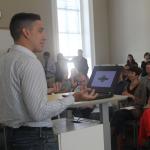In an article published this week, School of Information master's student Philipp Gutheim proposes a new infrastructure to support context-sensitive applications on mobile phones.
The two most common contextual variables for today's technology are location and time. A context-sensitive weather application, for instance, can provide forecasts for your current location and current time.
Gutheim imagines the possibility of richer, more complex context information, such as the user's typical daily routines, what tasks the user is doing at the moment, or what other people are with the user. “For instance, a cell phone that is aware of its user’s daily commute can send out reminder when the train is about to arrive,” explains Gutheim.
The article “An Ontology-based Context Inference Service for Mobile Applications in Next Generation Networks,” published in the January 2011 issue of IEEE Communications Magazine, describes a “context-inference platform” that would be easier, more accurate, and less error-prone.
While current models aggregate user data from the phone's operating system and built-in sensors, Gutheim's proposed model takes an “application store” approach. Mobile applications would be able to connect to a context platform, which would be run by the telecommunications operator. The application would provide information about the user, and in return would receive context information inferred by the platform.
Gutheim anticipates that this modular architecture could be adopted quickly by application developers, allowing them to offer “enriched services that are specifically tailored to the user’s situation.”
Gutheim came to the School of Information from Germany, where he previously worked for the mobile telecommunications company Vodaphone (which also funded this research). He also spent a semester as a visiting student researcher at the School of Information in 2009, while studying at Munich's Ludwig-Maximilians University, through an exchange between the I School and the Center for Digital Technology and Management (CDTM).








